This was published 2 years ago
Olympic comeback for stadium in suburbia leaves some offside
The latest plan for Ballymore will see it welcome multiple sports and host Olympic hockey games in 2032. That’s quite a rebound for a site government officials deemed unsuitable for a major stadium “either now or into the future”.
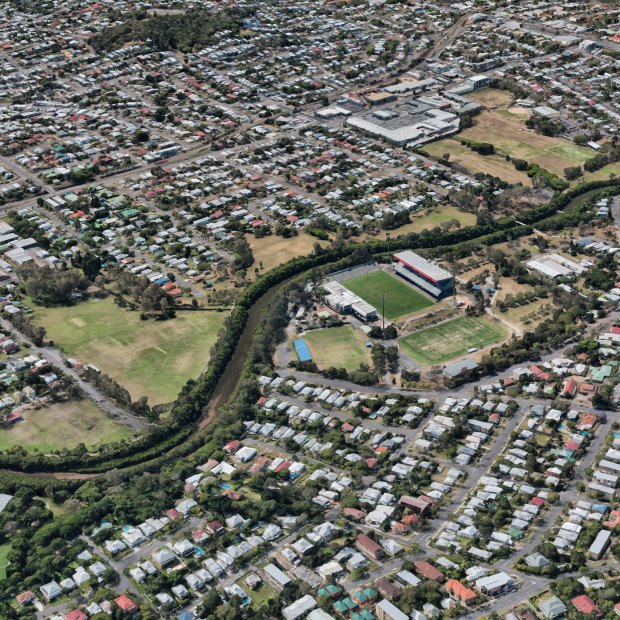
Ballymore sits in the middle of residential suburbia.Credit: Google Earth
While controversy around the proposed rebuild of the Gabba has dominated headlines since Brisbane was awarded the 2032 Olympics, the selection of other venues across the south-east could prove just as contentious.
At the end of a quiet street in Herston, between homes and a tree-lined creek, the rugby stadium Ballymore is seeking a revival of Olympic proportions.
The former home ground of the Queensland Reds, Ballymore has had a much quieter life over the past decade or two. The Reds have long since moved to Suncorp Stadium.
But it is set to once again draw a crowd — and worldwide attention — due to its nomination as Brisbane’s Olympic hockey venue.
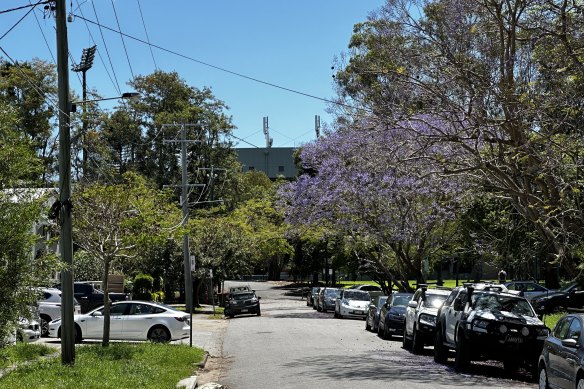
Ballymore’s eastern stand towers over Gould Road.Credit: Cameron Atfield
The Queensland government’s nomination seemed to go against the advice of its own 2018 Stadiums Taskforce report.
“As a major event destination, the Ballymore site does not meet contemporary standards that the taskforce has identified as preferred for major sports facility development in Queensland, as it is land locked, located in a residential neighbourhood and has limited potential for high frequency and multi-modal public transport,” the report found.
The taskforce recommended the “current Ballymore grandstands be demolished and a community facility be constructed that caters to training and local community rugby union matches” and noted it should “not be considered a major stadium facility ... either now or into the future”.
“The Ballymore venue is more aligned to being a training, club participation and administrative hub for rugby and compatible sports as opposed to being a location for a major stadium,” the taskforce found.
How the government, only three years later, came to the conclusion Ballymore could be an Olympic stadium remains cloaked in secrecy. A Right to Information request for documents was denied on cabinet-in-confidence grounds.
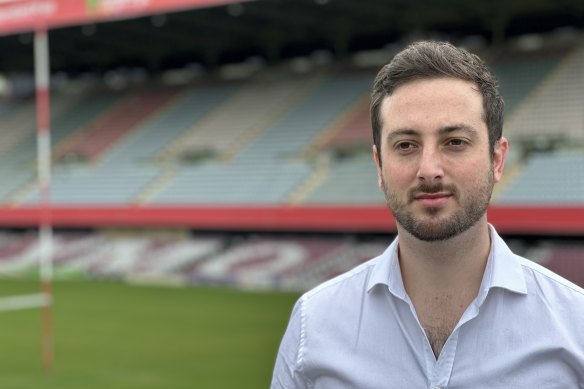
Local federal MP Stephen Bates says Ballymore is not an appropriate location for an Olympic venue.Credit: Cameron Atfield
“The whole Olympics bid process was done behind closed doors,” local federal Greens MP Stephen Bates said.
Hockey Queensland also appeared less than enthused about the decision.
“Hockey Queensland is exploring options for 2032 and has no comment at this time,” a spokeswoman said.
The Queensland Rugby Union’s ambitions go well beyond 2032. Chief executive David Hanham said they planned to put the old venue firmly back on the sports map.
Major events at the Herston stadium are a distant memory. Boarded-up bars beneath the eastern stand are covered in graffiti and pigeon droppings form small mountains where people once lined up for beers.
On the other side of the pitch, a new 3010-seat western stand, which will house the $30 million National Rugby Training Centre, is taking shape.
Bates said he supported the “much-needed” work, but that did not mean it was the right place for a major sports venue.
“It’s in the middle of suburbia, it’s got very, very limited modes of public transport that can be used — there’s basically one bus that goes in, essentially,” he said.
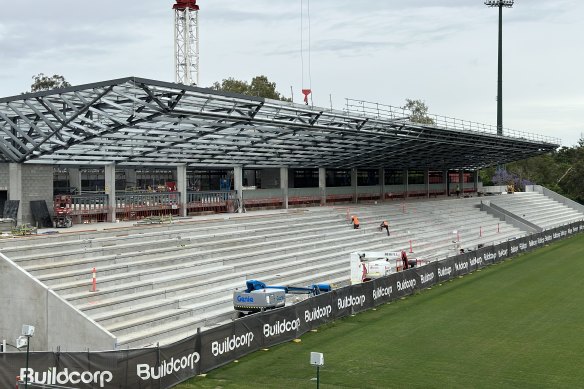
Construction of the new western stand at Ballymore.Credit: Cameron Atfield
“Residents already have issues with parking and traffic and everything else like that, and then whacking an Olympic stadium in here seems to be against the advice of the government’s own taskforce.”
Hanham said, ultimately, the QRU wanted the taxpayers’ investment to result in the home of rugby becoming the home of a range of sports, giving rugby additional revenue streams.
“It can be a venue for rugby, it can be a venue for football, a venue for hockey venue for all different rectangular codes,” he said.
Nestled as it is among residential streets, there is nothing like the Caxton Street or Logan Road precincts, near Suncorp Stadium and the Gabba respectively, for sports fans to meet, drink and eat before and after events.
Hanham said that lack of commercial activity in the area on event days would be offset by temporary bars and “Eat Street”-style offerings on Ballymore’s practice fields.
Not everyone will be happy to see Ballymore’s revival.
Anne Boccabella, who has been active in local campaigns for years, was angry to learn of the return of Ballymore as a major sports venue.
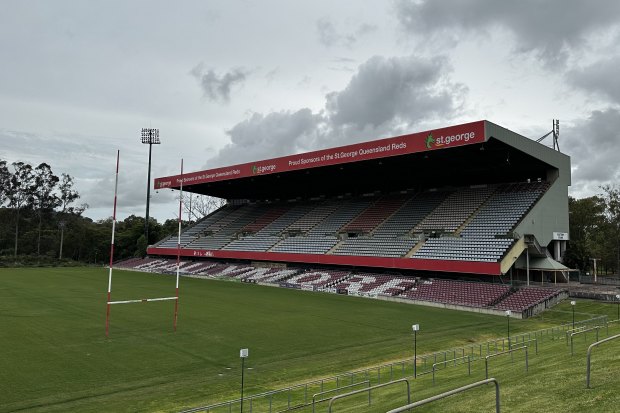
Ballymore’s eastern stand, which the Queensland government’s Stadiums Taskforce recommended be demolished.Credit: Cameron Atfield
For Boccabella, it brought back memories of parked-out streets, drunken behaviour in otherwise quiet residential streets and emergency vehicles unable to quickly get to the nearby Royal Brisbane and Women’s Hospital because of the game-day traffic snarl.
“If you were a planner and you were doing an impact assessment, I don’t think there’s a hope in hell you would ever choose that site,” she said.
But opposition is not universal.
Yuki Pam is the co-owner of Gia Cafe, not far from the stadium on Butterfield Street.
Pam counts several Reds players as regular customers and learnt of Ballymore’s resurrection as a major sports venue from this masthead.
“From a business perspective, we’d love it,” Pam said.
The QRU has been looking for a new use for Ballymore — and the government funding to make it happen — for years. But its location is one thing that cannot change.
Professor Matthew Burke, the deputy director of Griffith University’s Cities Research Institute (and not, like his namesake, a former Wallaby), said the constraints of the site were clear.
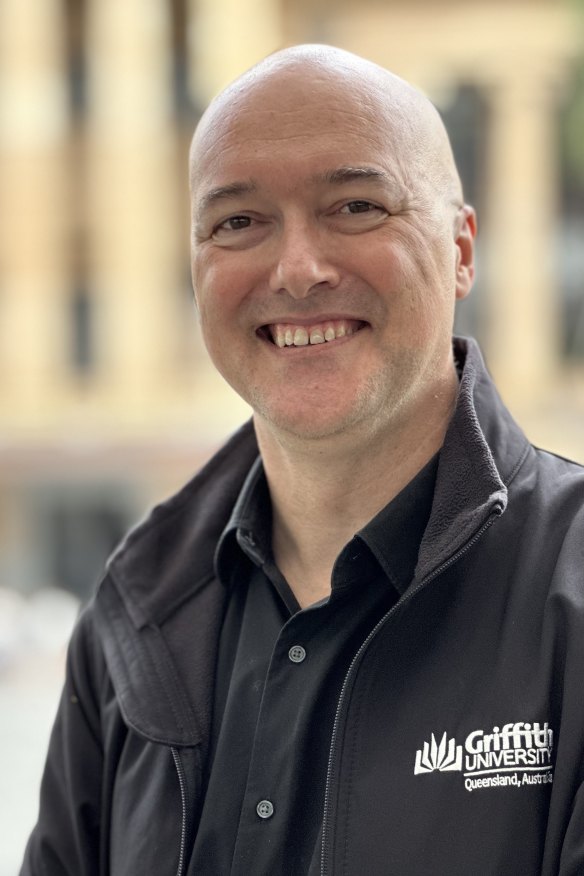
Griffith University deputy director of the Cities Research Institute Professor Matthew Burke.Credit: Cameron Atfield
“It’s got flooding issues, obviously, but more importantly it’s got transport issues,” he said.
Those flooding issues, demonstrated in February, caused Brisbane City Council to cancel the contentious proposed revamp of the 52-hectare Enoggera Creek Sport and Recreation Precinct, across the creek from Ballymore.
Queensland University of Technology urban planner Mark Limb, who lives “just around the corner” from Ballymore, said he knew first-hand how tricky transport in and out of the venue could be.
“Thinking about games that I’ve been to there, particularly big ones like when the Reds would play there, you’re either in the bus or otherwise it’s just this conga line of traffic,” he said.
But it would not be impossible.
Deputy Premier Steven Miles, who is overseeing Olympic infrastructure, said he was confident the site would meet both spectator and International Olympic Committee requirements.
“Ballymore will be a 1.1-kilometre walk to rail services at Wilston train station and 1.3-kilometre walk to bus and future Brisbane Metro services at Herston bus station,” he said.
“Shuttle buses will be provided between the venue and stations for those with mobility requirements. This meets the accessibility requirements of the IOC.
“Ballymore’s access to high-frequency and multi-modal public transport is comparable to, if not better than, the Sydney 2000 hockey facilities at Sydney Olympic Park.”
The Sydney hockey centre is a 1.2-kilometre walk from the Olympic Park train station at Homebush. That walk is along wide, straight boulevards within the Olympic Park precinct.
To get to Ballymore, on the other hand, would require a walk through narrow residential streets.
Burke said Ballymore might just pass the test for a one-off event like the Olympics. But, going forward, he felt the Stadiums Taskforce was on the money in 2018.
Miles said Ballymore was chosen because it was an existing venue, which had planned upgrades, and met Olympic hockey event requirements.
“These requirements include that the venue needs to incorporate two competition fields, grandstands for 10,000 and 5000 spectators respectively, and an adjacent warm-up field,” he said.
“At approximately 10 hectares, the Ballymore venue has space and facilities to accommodate three temporary hockey fields, grandstands and other IOC temporary overlay requirements including spectator, athlete, officials, games family, media, broadcast and operations facilities.”
According to the International Hockey Federation, a warm-up field adjacent to the main Olympic venue is “preferred” but “not a requirement”.
Hanham said, for non-Olympic events, a big part of Ballymore’s transport strategy would be to have people arrive earlier and leave later.
To that end, he anticipated a festival-like atmosphere on major event days. Hospitality tents would be erected on practice fields and people would be encouraged to stay in the precinct before and after matches.
To borrow a phrase made famous during the pandemic, that approach aimed to “flatten the curve” and not overwhelm public transport services.
“It’s not a venue you can drive your car to and go park on field two and then walk into the game, which happened in the old days,” he said.
The work already underway on the western side of the ground will not be the end of renovations.
The eastern stand, with its capacity of 7000 more than twice the new stand, will require investment to get it up to Olympic standard.
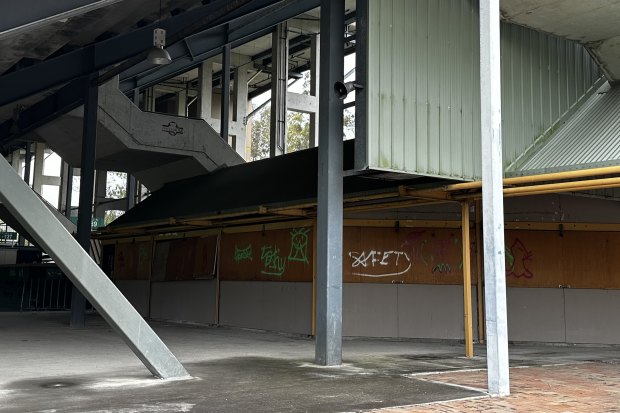
Beneath the eastern stand.Credit: Cameron Atfield
“It’s had the sun hitting it for 30 years, so it needs new seating, it needs new corporate facilities, it needs food and beverage outlets, it needs better amenities,” Hanham said.
“But once that’s done, it’s a good venue.”
Hanham said, for all its faults, Ballymore could offer visitors a unique experience.
“Ballymore’s point of difference is about the overall experience, because you’ve got a venue that’s got green space activation areas and that’s its unique selling point,” he said.
“It also enables us to create a wide green precinct that is very close to Victoria Park, it’s very close to that green corridor that leads you into Roma Street, so I think it connects well to the overall Olympic green corridor from Ballymore into the city.
“And then I think the other part of it, really, is the legacy. It’s a multi-sport venue that will cater for professional sport, community sport and the local community.
“That, to me, is what we’ve got to focus in on.”